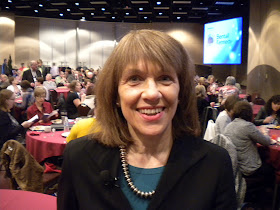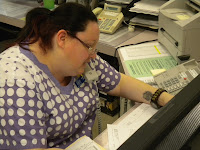People are talking more and more about patient-centered care. What does this mean? It means having a health care system that allows and encourages greater participation in people’s preventative care and, when they need it, in medical treatment at their doctor’s office or hospital. But it takes two to tango in this kind of world. Obviously, doctors and nurses and other health care providers need to be open to this partnership. But patient-centered care also relies on patients to be more informed consumers.
“Oh, no,” you are saying, “He wants me to be an expert. That’s why I go to my doctor in the first place.” Not at all. I just want you to know that you can help your own cause by being informed. But, like you, I want this to be an easy as possible, and I don’t want to spend a lot of time doing it. I want it to be interesting, and maybe even fun.
Along those lines, here are two free services that can help you be a more educated health care partner. I think they are really well written and engaging. You will even like reading them when you do not need medical care.
uPrevent
I don’t know about you, but I am often at a loss when I read or hear stories about great new advances in medicine. What does this new research mean to me or my elder relatives or to my children? Where can I learn more to help me translate a two-minute story on television, to decide if it matters?
Well, Aaron Rosado and some fellow students at the Emory University School of Medicine want to help. They created a website called uPrevent. Aaron sent me a Facebook message the other day telling me about it, noting, “Our main goal is to produce a body of distilled knowledge for people compiled from numerous peer reviewed resources that simplifies information allowing for greater accessibility. Our goal is to create a blog that empowers people with information they can use to make informed decisions about their lifestyle and healthcare.”
As you can tell from this Facebook profile picture (!), these are well intentioned and generous young people. They note: “We . . . derive no profit from these pages, nor do we intend to. We are not selling any treatments nor do we have any financial interest in any companies selling medical products. The information on the site is presented for the sole purpose of disseminating health information for general educational purposes only.”
I checked out the site and found it readable and interesting. There are stories on a number of topics, for example, birth control, weight loss surgery, and ankle sprains. There are also stories about lifestyle choices. For example, one article discusses the Mediterranean diet and explains the health benefits of it. The articles assimilate the latest research advances, and at the end of each article is a list of technical papers and other resources for those who want to dig in further. But, you don’t need to do that to get a lot of good information.
Journal of Participatory Medicine
For those who want to focus on improving the doctor-patient or nurse-patient relationship, there is the Journal of Participatory Medicine. This is published by the Society for Participatory Medicine, which defines itself as part of a movement in which “networked patients shift from being mere passengers to responsible drivers of their health, and in which providers encourage and value them as full partners.” The journal is a peer-reviewed and freely available to all “with the mission to advance the understanding and practice of participatory medicine among health care professionals and patients.” The editorial board of JPM comprises an impressive array of people from a variety of backgrounds who have banded together in support of this cause.
You will find different kinds of articles at JPM. There are often pieces offering examples of where and how medical partnerships work. For example, a recent editorial by editors Joe and Terry Graedon entitled “Making Every Second Count” has the following teaser: “Let’s face it, the good old days when you could schmooze with your doctor are long gone. But there are ways for patients to make every second count during brief office visits.”
But there are also articles about cases where that kind of partnership is non-existent. There is research on how to improve the patient-doctor experience.
In other words, JPM is not about specific diseases and cures. It is about ways to improve the practice of medicine and the delivery of care by building stronger relationships between patients and their health care providers. The perspectives offered are valuable, and you might find that you can apply the lessons to your own life or that of a loved one.
“Oh, no,” you are saying, “He wants me to be an expert. That’s why I go to my doctor in the first place.” Not at all. I just want you to know that you can help your own cause by being informed. But, like you, I want this to be an easy as possible, and I don’t want to spend a lot of time doing it. I want it to be interesting, and maybe even fun.
Along those lines, here are two free services that can help you be a more educated health care partner. I think they are really well written and engaging. You will even like reading them when you do not need medical care.
uPrevent
I don’t know about you, but I am often at a loss when I read or hear stories about great new advances in medicine. What does this new research mean to me or my elder relatives or to my children? Where can I learn more to help me translate a two-minute story on television, to decide if it matters?
Well, Aaron Rosado and some fellow students at the Emory University School of Medicine want to help. They created a website called uPrevent. Aaron sent me a Facebook message the other day telling me about it, noting, “Our main goal is to produce a body of distilled knowledge for people compiled from numerous peer reviewed resources that simplifies information allowing for greater accessibility. Our goal is to create a blog that empowers people with information they can use to make informed decisions about their lifestyle and healthcare.”
As you can tell from this Facebook profile picture (!), these are well intentioned and generous young people. They note: “We . . . derive no profit from these pages, nor do we intend to. We are not selling any treatments nor do we have any financial interest in any companies selling medical products. The information on the site is presented for the sole purpose of disseminating health information for general educational purposes only.”
I checked out the site and found it readable and interesting. There are stories on a number of topics, for example, birth control, weight loss surgery, and ankle sprains. There are also stories about lifestyle choices. For example, one article discusses the Mediterranean diet and explains the health benefits of it. The articles assimilate the latest research advances, and at the end of each article is a list of technical papers and other resources for those who want to dig in further. But, you don’t need to do that to get a lot of good information.
Journal of Participatory Medicine
For those who want to focus on improving the doctor-patient or nurse-patient relationship, there is the Journal of Participatory Medicine. This is published by the Society for Participatory Medicine, which defines itself as part of a movement in which “networked patients shift from being mere passengers to responsible drivers of their health, and in which providers encourage and value them as full partners.” The journal is a peer-reviewed and freely available to all “with the mission to advance the understanding and practice of participatory medicine among health care professionals and patients.” The editorial board of JPM comprises an impressive array of people from a variety of backgrounds who have banded together in support of this cause.
You will find different kinds of articles at JPM. There are often pieces offering examples of where and how medical partnerships work. For example, a recent editorial by editors Joe and Terry Graedon entitled “Making Every Second Count” has the following teaser: “Let’s face it, the good old days when you could schmooze with your doctor are long gone. But there are ways for patients to make every second count during brief office visits.”
But there are also articles about cases where that kind of partnership is non-existent. There is research on how to improve the patient-doctor experience.
In other words, JPM is not about specific diseases and cures. It is about ways to improve the practice of medicine and the delivery of care by building stronger relationships between patients and their health care providers. The perspectives offered are valuable, and you might find that you can apply the lessons to your own life or that of a loved one.





























